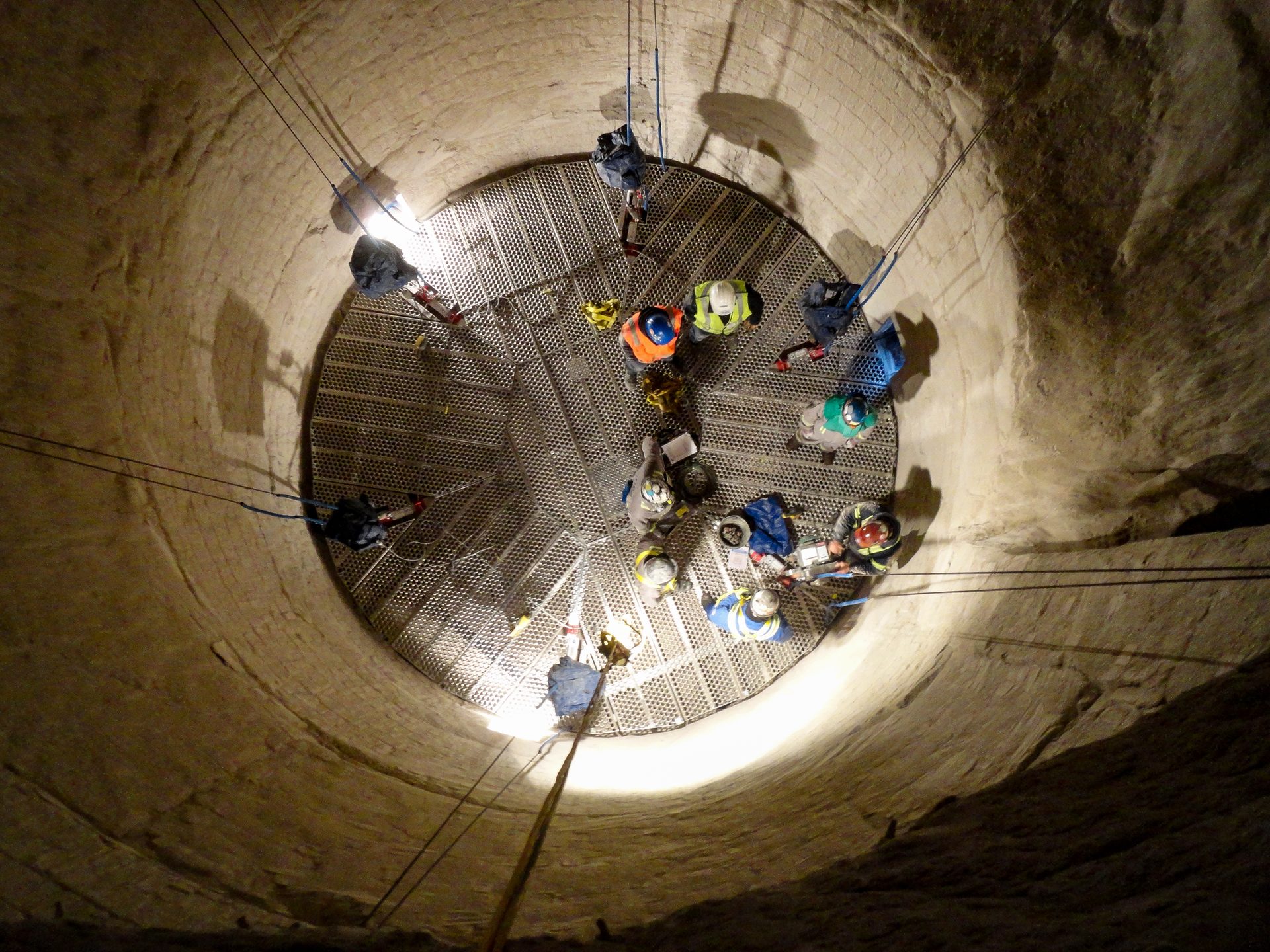MENU
Ceramics & Refractories/Insulation
Fig. 1. To gain earlier access to kilns and to increase safety and productivity, some facilities employ heavy-duty, remote-controlled demolition robots for descaling and debricking applications.
Revolutionizing Refractory Maintenance
Fig. 1. To gain earlier access to kilns and to increase safety and productivity, some facilities employ heavy-duty, remote-controlled demolition robots for descaling and debricking applications.
Lars Lindgren – Brokk Inc.; Monroe, Wash.
Heather Harding – Bricking Solutions; Monroe, Wash.
Refractory maintenance, though vital, can often be a logistical and financial burden. This is especially true for large facilities that rely on kilns, coolers, preheater towers and risers for day-to-day operation. These facilities stand to lose upward of $50,000 a day in production if their refractory can’t stand up to the heat.
To avoid unnecessary production loss, most facilities take on large-scale refractory removal and re-installation during annual maintenance shutdowns. Managers know how quickly these precious weeks fly by with crews struggling to complete as many maintenance tasks as possible. Establishing an efficient refractory removal and installation process is important for maximizing productivity during these cycles, which is why many facilities employ innovative, specialized equipment that increases safety and minimizes downtime during refractory maintenance. From robotic removal to fast, ergonomic installation, here’s how facilities around the world are increasing refractory maintenance efficiency.
Demolition Robots
With their position at the heart of the cement process, rotary kilns present a significant challenge to maintenance timelines when it comes to removing and re-installing refractory. Getting kilns up and running quickly is important to restarting production, but long cool-down times mean crews can’t even start descaling until well into shutdown. In addition, descaling and debricking have traditionally relied on large crews with hand tools such as jackhammers. This removal method comes with a number of drawbacks, including low productivity and increased risk of injury from equipment or falling debris.
To gain earlier access to kilns and to increase safety and productivity, some cement facilities employ heavy-duty, remote-controlled demolition robots for descaling and debricking applications. These ruggedly designed machines can withstand extreme temperatures, allowing facilities to begin descaling operations earlier than with any other method. The operator remains outside the kiln, away from the heat and the risk of falling debris.
Demolition robots also offer an unbeatable power-to-weight ratio, with the most innovative models performing on par with machines three times their size. Those in the 3,500- to 8,000-pound range can safely drive across the cooler using the facility’s kiln access ramp – like skid steers or other support equipment – and aren’t heavy enough to cause damage to the kiln shell. Despite their compact size, some models can deliver up to 855 joules of hitting power at 550-1,250 blows per minute.
Top-tier demolition robots feature an innovative three-part arm, which requires less height to extend compared to a mini-excavator with monoboom – only 72-84 inches in most cases. This is ideal for work in kilns and other confined spaces. With a vertical reach of 15.8-21 feet and a horizontal reach of 14.4-20 feet, cement facilities are able to fit the demolition robot to their specific kiln.

For one independent refractory contractor, adding a demolition robot to its crew significantly reduced overhead while increasing tear-out productivity. Relying on the robot’s remote operation, the company virtually eliminated falling debris injuries, which resulted in a reduced experience modification rate (EMR) and lower insurance premiums. The contractor also reduced crew size for descaling and debricking by 75% while achieving removal rates up to 33 feet per hour. Reallocated crew members were then able to increase productivity on other tasks, leading to a boost in overall efficiency.
Kilns aren’t the only place robotic demolition is increasing productivity and safety for refractory removal. This method has also been applied to coolers and feed shelves. In addition, equipment manufacturers recently developed a robotic solution for descaling in preheater towers.
Like kilns, traditional refractory removal in these vessels often involves handheld tools. However, preheater towers have an additional challenge – their vertical orientation. This requires crews to perform handheld breaking from scaffolding, resulting in long setup times, low productivity and difficult working conditions. Erecting the scaffolding system means a slow start to maintenance – once temperatures cool enough for crews to enter at all. More importantly, vessel design results in workers removing hundreds of tons of overhead refractory, making the process not only physically draining but extremely dangerous.
Fig. 2. The descaler demolition robot eliminates the need to have crews removing overhead refractory and can save facilities well over 100 hours in preheater tower applications.
A specially adapted demolition robot removes these hurdles, requiring zero physical contact and saving crews well over 100 hours in certain situations. The unit features a highly maneuverable three-part arm featured on some demolition robots. This is attached to the end of a platform-mounted telescopic boom. The boom is extendable by up to two sections, allowing for descaling in vessels up to 31.2 feet (9.5 meters) in diameter. Personnel never need to enter the tower thanks to remote-controlled operation, eliminating the risk of falling debris, silica dust and other confined-space hazards.
The descaler demolition robot can be set up in less than three hours depending on preheater tower specifications, saving facilities considerable time and resources compared to scaffolding. Because it is based on a heavy-duty demolition design, the descaler robot can also stand up to much hotter temperatures. This allows facilities to begin tear-out operations when the ambient temperature reaches 176°F (80°C), advancing their maintenance timeline significantly.

Fig. 3. Hydrodemolition allows facilities to keep crews out of the most dangerous situations through remote-controlled operation.
Hydrodemolition Robots
Hydrodemolition robots provide another efficiency-enhancing solution for refractory removal in tight spaces such as risers and transfer lines. This method uses high-pressure water jets to break up refractory materials without damaging embedded V-anchors, hex mesh or the steel mounting surface, resulting in faster, more cost-efficient maintenance.
Employing hydrodemolition allows facilities to keep crews out of the most dangerous situations through remote-controlled operation. Compact, highly versatile hydrodemolition robots can access confined spaces, with some units able to operate just 14 inches from the surface to be demolished. This water-based removal method eliminates silica dust while leaving a cleaner surface that doesn’t require additional sand blasting or power washing. This not only increases safety, it eliminates a step to accelerate maintenance timelines.

Fig. 4. Bricking machines with a dual arch offer increased productivity by permitting installation of a second ring of bricks while the first is being keyed.
Hydrodemolition robots also provide a significant productivity boost compared to hand-removal methods. At 18,000 psi, hydrodemolition equipment can provide 100 times the productivity of handheld equipment, removing 9.5 cubic feet of refractory per hour compared to just 0.1 cubic foot with a 15-pound pneumatic hammer. This productivity, paired with the robot’s ability to work on vertical, horizontal, overhead and curved surfaces without tiring, means facilities can make significant gains during refractory removal for a faster return to operation.
To maximize hydrodemolition productivity and overall versatility, many facilities and independent contractors partner with equipment manufacturers to provide solutions tailored to their unique needs. There are several hydrodemolition options available for refractory removal, but not all provide the same level of control and productivity. One important variable that can lead to gaps in efficiency is the distance between the nozzle and the refractory surface.
Simple automated setups, such as those used in risers that feature a rotating nozzle and stabilizing ring, might have several inches between the nozzle and the refractory surface. This distance results in a significant loss in power by the time the water reaches its mark, causing operators to compensate with a higher flow rate. A robotic system operating within 0.5 inches of the refractory surface, on the other hand, doesn’t suffer this loss of power, creating better removal rates per pump hour and better fuel and water efficiency. This type of system also allows the operator to set parameters, including the lance speed and angles, to optimize efficiency.
Refractory Installation
Increasing efficiency for removal is only half of the equation. To get production up and running again quickly, facilities also need to maximize productivity during refractory installation. Unlike removal, there is no high-tech replacement for a master mason, meaning installation can only move as fast as bricking crews. Most masons employ a bricking machine in rotary kiln applications, which offers increased productivity and better ergonomics for fast, high-quality refractory installation.
Efficiency starts with bricking machine setup. Those constructed of strong yet lightweight modular aluminum components are easy to maneuver into the kiln and can be assembled in just 60-90 minutes by an experienced crew. Steel models might take 6-8 hours and require additional support equipment. Modern bricking machines feature a pneumatic arch that raises bricks into place against the kiln shell and holds them there, eliminating the more physical aspects of traditional refractory installation. In addition, the pneumatic arch system provides results that can extend the longevity of refractory by as much as 25%.
Bricking machines with a dual arch further increase productivity by permitting a second ring of bricks to be installed while the first is being keyed. This design features a cutaway section at the front of the arch that provides an unobstructed area to place key bricks. Machines without this feature force installers to try to find other ways to reach around the arch, reducing installation speed and, in some cases, quality.

Fig. 5. Custom-designed suspended platforms are being used by industrial facilities as a solution for brick and spray refractory installation in lime kilns, precalciners, cyclones, ISAMELT furnaces and preheater towers.
Bricking machines from leading manufacturers allow masons to tailor equipment to fit the kiln and their particular process for a more comfortable experience. Machines are available in a variety of sizes. Recently, a stair-stepped deck design was released that allows support equipment, such as skid steers, to drive under the machine for more efficient brick management.
Specialized equipment can also make maintenance more efficient in vertical vessels. Custom-designed suspended platforms are being used by cement and other facilities as a solution for brick and spray refractory installation in lime kilns, precalciners, cyclones, ISAMELT furnaces and preheater towers. These lightweight metal platforms are erected inside the vessel and raised or lowered using manual or electric hoists for hassle-free maintenance and relining applications. Suspended platforms eliminate the need for complex scaffolding systems. Those featuring a modular design and pin-together construction can be set up in as little as two hours.
Suspended platforms also provide ample surface area and capacity for personnel, tools and materials such as refractory brick and gunning equipment. Therefore, refractory installation can progress faster since there’s no need to hoist supplies up and down. This also reduces the physical strain on workers and the risk of falls, resulting in a safer work environment and decreased overhead.
Conclusion
When it comes to refractory maintenance, what comes down must also go back up before the job can be considered complete. Increasing efficiency throughout the process means facilities can start up production that much quicker. Working with specialized equipment can greatly increase productivity, safety and overall quality of refractory maintenance. Whether it’s a robotic solution for removal, a custom-designed platform or bricking machine for installation or a combination of both, industrial facilities can revolutionize refractory maintenance by investing in the right tools.
For more information: Lars Lindgren is president of Brokk Inc. He can be reached at lars@brokkinc.com or 800-621-7856. Heather Harding is managing director at Bricking Solutions. She can be reached at heather@brickingsolutions.com or 360-794-1277.
All graphics provided by the authors.





